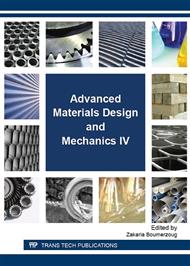[1]
P. Greil,. Biomorphous ceramics from lignocellulosics, J. Eur. Ceram. Soc., vol. 21, no. 2, (2001), 105–118.
Google Scholar
[2]
E. Wheeler, Wood : Macroscopic anatomy, Encyclopedia of Materials: science and Technology, Vol 10. (2001) 9653–9657.
DOI: 10.1016/b0-08-043152-6/01749-6
Google Scholar
[3]
P. D. J. 3. Rubin Shmulsley,. Forest Product & Wood Science, an Introduction. Wiley Blackwell. (2010).
Google Scholar
[4]
L. Esposito, a. Piancastelli, C. Melandri, and D. D. Fabbriche Microstructure and Compressive Strength of Porous SiC Derived from Wood, Key Eng. Mater., vol. 264–268, (2004)2195–2198.
DOI: 10.4028/www.scientific.net/kem.264-268.2195
Google Scholar
[5]
D. Meier and O. Faix,. LOCiY State of the art of applied fast pyrolysis of lignocellulosic materials a review, vol. 68, (1999)71–77.
DOI: 10.1016/s0960-8524(98)00086-8
Google Scholar
[6]
M. Bellais, Modelling of the pyrolysis of large wood particles. (2007).
Google Scholar
[7]
J. Locs, L. Berzina-Cimdina, a. Zhurinsh, and D. Loca,. Effect of processing on the microstructure and crystalline phase composition of wood derived porous SiC ceramics, J. Eur. Ceram. Soc., vol. 31, no. 1–2, (2001) 183–188.
DOI: 10.1016/j.jeurceramsoc.2010.08.009
Google Scholar
[8]
F. M. Varela-Feria, J. Ramírez-Rico, A. R. de Arellano-López, J. Martínez-Fernández, and M. Singh, 2008. Reaction–formation mechanisms and microstructure evolution of biomorphic SiC, J. Mater. Sci., vol. 43, no. 3, (2008) 933–941.
DOI: 10.1007/s10853-007-2207-4
Google Scholar
[9]
M. Presas, J. Y. Pastor, J. Llorca, a. R. A. López, J. M. Fernández, and R. Sepúlveda,. Microstructure and fracture properties of biomorphic SiC, Int. J. Refract. Met. Hard Mater., vol. 24, no. 1–2, (2006) 49–54.
DOI: 10.1016/j.ijrmhm.2005.07.003
Google Scholar
[10]
J. Qian, J. Wang, and Z. Jin, Preparation of biomorphic SiC ceramic by carbothermal reduction of oak wood charcoal, Mater. Sci. Eng. A, vol. 371, no. 1–2, (2004) 229–235.
DOI: 10.1016/j.msea.2003.11.051
Google Scholar
[11]
Mohd Zin Jusoh, Kayu, struktur, sifat dan Penggunaan, (1989).
Google Scholar
[12]
H. S. C. Zolfrank,. Microstructure evolution and reaction mechanism of biomorphous SiSic ceramic, Am. Ceram. Soc, vol. 88, (2005) 51–58.
DOI: 10.1111/j.1551-2916.2004.00028.x
Google Scholar
[13]
D. Mohan, C. U. Pittman, and P. H. Steele, Pyrolysis of Wood/Biomass for Bio-oil: A Critical Review, Energy & Fuels, vol. 20, no. 3, (2006) 848–889.
DOI: 10.1021/ef0502397
Google Scholar
[14]
P. C. Michael Scheffler, Cellular Ceramics Structure, Manufacturing, Properties,. wiley-vch, (2005).
Google Scholar
[15]
N. R. Calderon, M. Martinez-Escandell, J. Narciso, and F. Rodríguez-Reinoso, The role of carbon biotemplate density in mechanical properties of biomorphic SiC, J. Eur. Ceram. Soc., vol. 29, no. 3, (2009) 465–472.
DOI: 10.1016/j.jeurceramsoc.2008.05.049
Google Scholar
[16]
W. D. Callister, Materials Science and Engineering An Introduction. 4th editionJohn Wiley & Sons Inc , (1997).
Google Scholar
[17]
J. C. Margiotta. "study of silicon carbide formation by liquid silicon infiltration of porous carbon structures, Johns Hopkins University, (2009).
Google Scholar
[18]
A. Esther and S. Childers, Processing , Microstructure , and Mechanical Properties of Interpenetrating Biomorphic Graphite / Copper Composites, Northwestern university, (2014).
Google Scholar


